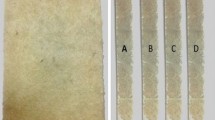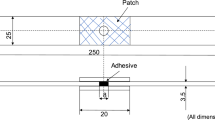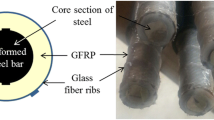Abstract
The chopped strand mat (CSM) glass fiber-reinforced polyester composite is commonly used for building and repairing in various industrial fields. Its sensitivity to the edge notches has not been considered well in the literature. This paper studies the notch tensile strength (NTS) and fracture characteristics of the proposed composite under the influence of each of the strain rate, notch shape and size with three levels. Nine tests have been designed according to the Taguchi’s orthogonal array. Then, analysis of variance (ANOVA) has been applied to analyze the experimental results of the NTS. Different models of SEN specimens were simulated to predict the stress distribution and concentration. Results reveal that the notch size, notch shape and strain rate have the effectiveness of 46.7, 40 and 6.4% on the failure stress, respectively. The smallest U-shape notch and lowest strain rate conditions achieve highest notch tensile stress. The numerical simulation results confirm the experimental results.










Similar content being viewed by others
Data Availability
The datasets generated and analyzed during the current study are available from the corresponding author on reasonable request.
References
Suresha B, Chandramohan G, and Renukappa N, J. Appl. Polym. Sci. 103 (2007) 2472.
Dadfar M, and Ghadami F, Mater. Des. 47 (2013) 16.
Sathishkumar T, Satheeshkumar S, and Naveen J, J. Reinf. Plast. Compos. 33 (2014) 1258.
Nayak S, Heckadka S, Sadanand R, Bharadwaj K, Pokharna H, and Sanjeev A, J. Eng. Fib. Fabr. 12 (2017) 155.
Nayak S, Heckadka S, Thomas L, and Baby A, MATEC Web of Conferences 144 (2018) 2025.
Fung W 2002 Coated and laminated textiles (Woodhead Publishing)
Andersson C, Dartman T, Gredinger P, Asplund J, and Strandqvist H, Mech. Compos. Mater. 34 (1998) 525.
Arifin A, Abdullah S, Rafiquzzaman M, Zulkifli R, Wahab D, and Arifin A, Mater. Des. 59 (2014) 475.
Kaleemulla K, and Siddeswarappa B, Int. J. Mater. Prod. Technol. 31 (2008) 283.
Hong C, and Ji W, Compos. Commun. 17 (2020) 28.
Wang Z, Jiang J, and Chen N, J. Appl. Mech. Mater. 341 (2013) 49.
Tarnowski K, Nikbin K, Dean D, and Davies C, Exp. Mech. 58 (2018) 1003.
Papanicolaou G, Mouzakis D, Kosmidou T, and Economopoulos G, Polym. Compos. 27 (2006) 177.
Suman S, Khan M, Pathak M, and Singh R, Procedia Eng. 173 (2017) 1185.
Avci A, Arikan H, and Akdemir A, Cem. Concr. Compos. 34 (2004) 429.
Mahmoud M, Polym.-Plast. Technol. Eng. 42 (2003) 659.
Woo S, and Choi N, Compos. Sci. Technol. 67 (2007) 1451.
Nguyen M, and Waas A, Compos. Struct. 279 (2021) 114731.
Welsh L, and Harding J, J. Phys. Colloq. 46 (1985) 405.
Zhang S, Soden P, and Soden P, Compos. 17 (1986) 100.
Lindhagen J, and Berglund L, Polym. Compos. 18 (1997) 40.
Al-alkaw H, Al-Fattal D, and Baghdad B 2013 J. Eng. Sustain. Dev. 17
Ichikawa D, Hamada H, and Ohtani A, Open. J. Compos. Mater. 8 (2018) 110.
ASTM D1990 2019.
ASTM D5083 2017.
ASTM E1457-15 2015.
ASTM E1820-15 2015.
ASTM D3039-17 2017.
Kovač P, Rodić D, Pucovski V, Mankova I, Savkovic B, and Gostimirović M, J. Prod. Eng. 15 (2012) 1.
Acknowledgements
The author would like to acknowledge the Mechanical Engineering Department of Sulaimani Polytechnic University for their support. Special thanks to the Mechanical Department of Koya University for their Assistance.
Author information
Authors and Affiliations
Corresponding author
Additional information
Publisher's Note
Springer Nature remains neutral with regard to jurisdictional claims in published maps and institutional affiliations.
Rights and permissions
Springer Nature or its licensor (e.g. a society or other partner) holds exclusive rights to this article under a publishing agreement with the author(s) or other rightsholder(s); author self-archiving of the accepted manuscript version of this article is solely governed by the terms of such publishing agreement and applicable law.
About this article
Cite this article
Abdalrahman, R.M. Optimized Strength of Chopped Strand Mat Glass Fiber-Reinforced Polyester Laminates with Single-Edge Notch under the Effects of Notch Shape/Size and Strain Rate. Trans Indian Inst Met 76, 2857–2864 (2023). https://doi.org/10.1007/s12666-023-02979-1
Received:
Accepted:
Published:
Issue Date:
DOI: https://doi.org/10.1007/s12666-023-02979-1




